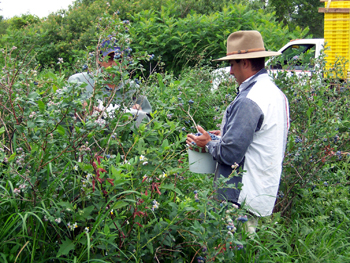Opening new markets for Michigan’s blueberries
Growers need to participate in the USDA-APHIS export programs to maintain a healthy growth of Michigan’s blueberry industry. This will allow Michigan to remain the number one blueberry producer in the nation and stabilize the internal blueberry market.
|
At the time when most sectors of Michigan’s economy were in recession, blueberry production became one of the significant economic drivers in west Michigan. Income generated by blueberry production surpasses that of apple production, which for many years was the leading fruit industry in the state. For example, according to the 2011 USDA Noncitrus Fruit and Nuts Summary, in 2010 the total value of blueberry production was $134.3 million versus $104.1 million for Michigan apple production.
Despite this success, strong competition from some fairly new blueberry production regions like Washington, Oregon and California affect the movement and prices of Michigan’s berries in our national market. Climatic conditions in those states allowed blueberries to prosper under less restrictive environmental conditions which provide a longer growing season than in Michigan, and with only a few insect and disease problems. Just in the past three years, blueberry production in the West Coast (including British Columbia, Canada) went from 198.1 million pounds in 2009 to 245 million pounds (NABC Crops estimates, October 2011). However, Michigan still remains the leading blueberry producer in the nation. With the exception of 2011 when Michigan’s blueberry production reached only 78 million pounds, its annual production fluctuates between 90 and 100 million pounds of blueberries.
Although blueberry demand by national and international markets has increased substantially, it is necessary to open new markets for Michigan blueberries to maintain the healthy growth of Michigan’s blueberry industry. One important opportunity for Michigan’s growers is international markets, mainly within the North American region such as Mexico and Canada. Asian markets, like China and Japan, may also be good destinations for Michigan’s blueberries.
|
Michigan’s proximity to major Canadian markets like the Province of Ontario makes it desirable to initiate negotiations to start exporting blueberries to these markets. This will contribute to a stabilization of blueberry prices, especially at the beginning of the blueberry harvest season. The major restriction that prevents the movement of Michigan’s blueberries into Canada is the presence of blueberry maggots,Rhagoletis mendax. Blueberry maggots are a pest native of North America and is present in the Great Lakes region.
Because the Ministry of Agriculture and Agri-Food Canada considers the Province of Ontario a “blueberry maggot-free area,” it imposes quarantine measures to blueberries imported from the United States. However, a work plan to export blueberries under a “systems approach” program is available to Michigan growers willing to comply with quarantine measures outlined in this protocol. Mike Bryan, nursery and export program manager from the MDARD will provide detailed information on this at our blueberry pre-season meeting on April 5 at the MSU Trevor Nichols Research Center in Fennville, Mich.
For growers interested in the export program for Canada, now is the time to register to participate in 2012. Obtain a copy of the work plan and register by contacting Mike Bryan at 517-241-2977 or Carlos García at 616-994-4580 (cell 616-260-0671).



 Print
Print Email
Email




